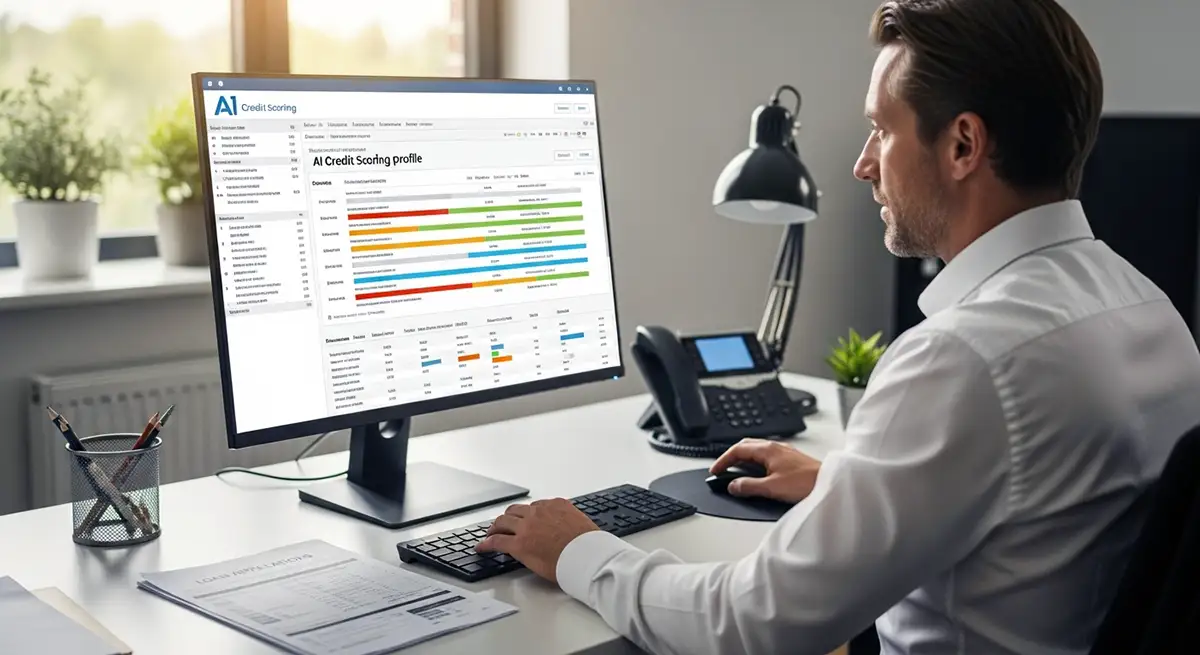
AI Credit Scoring Automation: Use Cases that Deliver ROI
Understanding AI Credit Scoring Automation
What is AI Credit Scoring Automation?
In the evolving landscape of financial technology, AI credit scoring automation has emerged as a transformative approach to evaluating creditworthiness. This innovative technique leverages artificial intelligence to analyze vast amounts of data, enabling lenders to make faster and more accurate assessments of potential borrowers. By utilizing machine learning algorithms, AI credit scoring automation can sift through diverse data sources, such as credit histories, transaction behaviors, and even social media activity, to create a comprehensive profile of an applicant's credit risk.
This automation not only streamlines the credit evaluation process but also enhances the decision-making capabilities of financial institutions. Traditional credit scoring methods often rely heavily on static data and standardized models, which can overlook unique individual circumstances. AI credit scoring automation addresses these limitations by providing a more nuanced understanding of credit risk, ultimately fostering a more inclusive lending environment.
How AI Credit Scoring Differs from Traditional Methods
The traditional credit scoring system has long relied on established models like FICO and VantageScore, which primarily focus on historical credit data. This methodology can often miss vital information about an individual's current financial behavior and broader economic factors. In contrast, AI credit scoring automation integrates a wider array of variables, including real-time data, to formulate a more dynamic assessment of an applicant's creditworthiness.
For instance, traditional methods may assign a credit score based on factors such as payment history, outstanding debt, and length of credit history. However, AI systems can also consider non-traditional data points, such as alternative credit scores derived from utility payments or rental histories. This holistic approach enables more accurate risk assessments, reducing the likelihood of unjustly denying credit to applicants who may not fit the traditional mold but are nonetheless capable of meeting their financial obligations.
Benefits of AI Credit Scoring Automation
Enhanced Accuracy in Credit Assessments
One of the most significant advantages of AI credit scoring automation is its ability to enhance the accuracy of credit assessments. By analyzing large datasets and identifying patterns that might go unnoticed by traditional methods, AI algorithms provide a more comprehensive view of an applicant's credit risk. This increased accuracy helps financial institutions make informed lending decisions, thereby reducing default rates and improving overall portfolio performance.
Moreover, AI systems continuously learn and adapt to new data, which means their predictive capabilities become increasingly robust over time. As these algorithms evolve, they can account for shifts in economic conditions, consumer behavior, and emerging trends, ensuring that credit assessments remain relevant and precise.
Reduced Time for Credit Decisions
In an age where speed is paramount, AI credit scoring automation significantly reduces the time required for credit decisions. Traditional credit evaluations can take days or even weeks, resulting in a frustrating experience for both lenders and borrowers. By automating the credit scoring process, AI systems can deliver real-time assessments, allowing lenders to provide immediate feedback to applicants.
This rapid turnaround not only enhances customer satisfaction but also improves operational efficiency for financial institutions. By streamlining the credit decision-making process, lenders can allocate resources more effectively and focus on cultivating relationships with customers rather than getting bogged down in lengthy evaluations.
Cost Efficiency and ROI Implications
The financial implications of AI credit scoring automation extend beyond just improved accuracy and speed. Implementing AI-driven credit scoring can lead to substantial cost savings for financial institutions. By reducing the labor and resources required for manual evaluations, organizations can achieve a favorable return on investment (ROI).
Moreover, the reduction in default rates due to more accurate assessments translates into increased profitability. By minimizing risks associated with lending, institutions can optimize their portfolios and drive sustainable growth. The compelling ROI presented by AI credit scoring automation makes it an attractive investment for organizations looking to enhance their credit operations.
How to Implement AI Credit Scoring Automation
Key Steps in Implementation
Implementing AI credit scoring automation requires a strategic approach to ensure that the technology aligns seamlessly with an organization’s existing operations. The first step involves conducting a thorough needs assessment to identify specific challenges within the current credit evaluation process. This assessment helps organizations pinpoint areas where AI can deliver the most significant impact.
Once the needs are identified, organizations should engage in a careful selection process to identify the most suitable AI tools and technologies. This involves evaluating various AI vendors and solutions to find the best fit for the institution's unique requirements.
Choosing the Right AI Tools and Technologies
The selection of AI tools and technologies is critical to the success of credit scoring automation. Organizations must consider factors such as scalability, integration capabilities, and the vendor's track record in the financial sector. A well-chosen AI solution will not only enhance the credit scoring process but also provide insights that can drive broader business strategies.
Additionally, organizations should prioritize solutions that offer transparency and interpretability, allowing stakeholders to understand how AI models reach their conclusions. This transparency is essential for fostering trust among decision-makers and ensuring compliance with regulatory standards.
Integrating AI Solutions with Existing Systems
Once the right AI tools have been selected, the next step is to integrate these solutions with existing systems. This integration can often present challenges, as legacy systems may not easily accommodate new technologies. A strategic approach involves collaborating with IT teams to ensure smooth interoperability between AI solutions and current credit management systems.
Furthermore, organizations must establish clear protocols for data management and security during this integration process. Safeguarding sensitive customer information is paramount, and compliance with relevant regulations must be maintained throughout the transition.
AI Credit Scoring Automation Best Practices
Ensuring Data Quality and Compliance
For AI credit scoring automation to deliver reliable results, organizations must prioritize data quality. Inaccurate or incomplete data can lead to flawed assessments and misguided lending decisions. Implementing robust data governance practices is essential to ensure that the data used in credit scoring is accurate, up-to-date, and compliant with regulatory standards.
Regular audits of data sources and processes can help organizations identify potential issues and rectify them proactively. Additionally, maintaining transparency in data usage and ensuring compliance with privacy regulations will foster trust with customers and regulatory bodies alike.
Continuous Monitoring and Improvement
AI credit scoring automation is not a one-time implementation but rather an ongoing process that requires continuous monitoring and improvement. Organizations should establish feedback loops to evaluate the performance of AI models regularly. By analyzing the outcomes of credit decisions made using AI, institutions can refine their algorithms to enhance accuracy further.
Moreover, ongoing monitoring helps organizations identify shifts in market conditions or consumer behavior that may necessitate adjustments in credit scoring models. This proactive approach ensures that AI credit scoring remains relevant and effective over time.
Training Stakeholders on New Technologies
To maximize the effectiveness of AI credit scoring automation, organizations must invest in training for stakeholders involved in the credit evaluation process. Ensuring that employees understand how to leverage AI tools and interpret their outputs is crucial for successful implementation.
Training programs should not only cover technical aspects but also emphasize the importance of ethical considerations in AI use. Stakeholders must be equipped to navigate potential biases in AI algorithms and ensure that lending practices remain fair and equitable.
AI Credit Scoring Automation Examples
Case Study: Financial Institutions Leveraging AI
Several financial institutions have successfully implemented AI credit scoring automation, reaping significant benefits in terms of efficiency and accuracy. For example, a prominent bank utilized an AI-driven model to enhance its credit evaluation process. By integrating alternative data sources, the bank was able to extend credit to underserved populations who had previously been overlooked by traditional scoring methods.
As a result, the bank not only expanded its customer base but also experienced a notable decrease in default rates. The use of AI allowed the institution to make data-driven decisions that aligned with its strategic goals while fostering financial inclusion.
Success Stories from FinTech Companies
FinTech companies are at the forefront of adopting AI credit scoring automation, often leading the charge in innovation within the financial sector. A notable success story involves a FinTech startup that developed an AI-powered lending platform tailored for small businesses. By utilizing machine learning algorithms, the platform was able to evaluate creditworthiness in real-time, providing businesses with immediate access to funding.
This approach not only streamlined the lending process but also empowered small business owners who may have struggled to secure loans through traditional channels. The startup's success illustrates the potential of AI credit scoring automation to disrupt conventional lending models and create new opportunities.
Real-World Applications in Different Industries
AI credit scoring automation is not limited to the traditional banking sector; its applications extend across various industries. For example, retail companies are increasingly using AI-driven credit scoring to assess customer financing options at the point of sale. By providing instant credit assessments, retailers can enhance the shopping experience while driving sales.
Similarly, insurance companies are leveraging AI credit scoring automation to evaluate risk profiles for policy applicants. By incorporating diverse data points, insurers can offer more personalized coverage options, ultimately improving customer satisfaction and retention.
Measuring the ROI of AI Credit Scoring Automation
Key Performance Indicators (KPIs) to Consider
To assess the ROI of AI credit scoring automation, organizations must identify key performance indicators (KPIs) that align with their strategic objectives. KPIs may include metrics such as reduction in credit decision turnaround time, improvements in approval rates, and decreases in default rates. By quantifying these metrics, organizations can gain valuable insights into the effectiveness of their AI credit scoring initiatives.
Additionally, monitoring customer satisfaction scores can provide a holistic view of the impact of AI automation on the overall lending experience. These insights can inform future strategic decisions and guide ongoing improvements in AI credit scoring practices.
Analyzing Cost Savings and Revenue Growth
A thorough analysis of cost savings and revenue growth is essential for understanding the financial implications of AI credit scoring automation. Organizations should evaluate both direct and indirect cost reductions associated with implementing AI solutions. Direct savings may stem from decreased labor costs and streamlined processes, while indirect savings can arise from improved customer retention and increased lending volumes.
Furthermore, organizations should consider the long-term revenue growth potential enabled by AI-driven credit scoring. By expanding access to credit and enhancing risk assessment capabilities, institutions can tap into new markets and drive sustainable growth.
Future Trends in AI Credit Scoring Automation
The Role of Machine Learning and Big Data
As technology continues to advance, the role of machine learning and big data in AI credit scoring automation will become increasingly prominent. Machine learning algorithms will continue to evolve, allowing for more sophisticated models that can adapt to changing market conditions and consumer behaviors. The integration of big data will further enrich credit assessments, enabling organizations to derive insights from a wider array of information.
This evolution will not only enhance the accuracy of credit scoring but also pave the way for more personalized lending experiences. As lenders gain deeper insights into consumer behavior, they can tailor their offerings to meet individual needs, fostering stronger customer relationships.
Anticipated Regulatory Changes and Their Impact
As AI credit scoring automation gains traction, regulatory bodies will likely respond with new guidelines and requirements. Organizations must stay informed about anticipated regulatory changes that may impact their AI credit scoring practices. This vigilance will ensure that institutions remain compliant while leveraging the benefits of AI technology.
Moreover, proactive engagement with regulators can help shape the development of policies that foster innovation while safeguarding consumer interests. By participating in discussions about responsible AI use, organizations can position themselves as leaders in ethical lending practices.
In conclusion, AI credit scoring automation represents a paradigm shift in how financial institutions assess creditworthiness. By harnessing the power of AI, organizations can enhance accuracy, reduce time for decisions, and achieve significant cost efficiencies. As the industry continues to evolve, adopting best practices and staying attuned to emerging trends will be critical for organizations looking to maximize the benefits of AI credit scoring automation. For more insights into how AI can transform your business operations, visit our page on Industry AI Applications.







No comment yet, add your voice below!